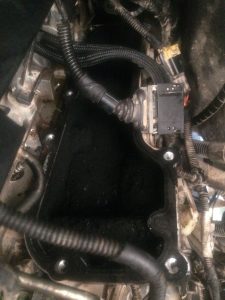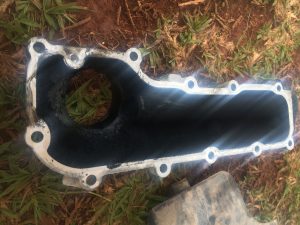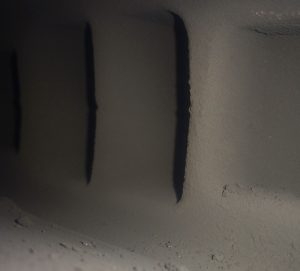Our Iveco Daily 4×4 55S17W, Cuthbert, has an engine equipped with emissions control systems to exceed the Euro 5 standard, and to meet the Enhanced Environmental Vehicle (EEV) standards. It’s not designed for the high sulphur diesel found in some countries of the developing world. Whilst researching vehicle options for our overlanding adventure to many of these countries, I found a lot of advice on the internet about disabling the emission control systems for high sulphur diesel environments. Supposedly, these emission control systems would cause the engine to fail in any country where good quality fuel is not available (i.e. pretty much anywhere outside of Europe).
With the benefit now of over three years’ experience operating Cuthbert in Africa and South America, my conclusion is that most of this internet advice on high sulphur diesel appears to be based on hearsay and old wives’ tales of doom and gloom. To try and set the record straight, I have used my engine diagnostic tool to carry out a factually based assessment on the engine’s performance, using varying qualities of diesel (including very high sulphur diesel) and importantly, with all the emission controls enabled,.
Mileage and fuel
At the time of writing (March 2017), Cuthbert has done 120,000 km, broken down as 29,324 km in Europe, 37,021 km in Africa and 53,655 km in South America. We have used some 18,905 litres of diesel. The fuel quality has varied from the good in Europe to the shockingly bad in Uganda and Bolivia where it was very high sulphur diesel. Most of the fuel used over the mileage would not meet the standard specified for a Euro 5 vehicle. We have not used any fuel additives!
Emission Control Systems
The emission controls on the vehicle consist of an Exhaust Gas Re-circulator (EGR), Diesel Particulate Filter (DPF) and Catalytic Converter (CAT) plus the EDC 17 engine management system precisely controlling a high pressure (1900 bar, 27,557 PSI) common rail fuel injection system.
The DPF
The very high pressure of the injection system produces very finely atomised fuel particles which burn very efficiently. The down-side to this is that the soot produced is very hazardous to the lungs, so these modern engines need a DPF in the exhaust to collect this dangerous soot output. I have written a lot more detail on the operation of the DPF, click here for more details. From my experience with this vehicle, there is no point in removing the DPF: it works well and can handle high sulphur diesel. At very high altitude e.g. in the high Andes, it is a little more critical to avoid high sulphur diesel (Click here for more details), but we operated Cuthbert up to 4,982m (16,345 feet) altitude without too much problem. Other than at very high altitude, Cuthbert’s DPF had no problems handling high sulphur diesel.
The CAT
This is used to convert any carbon oxide and hydrocarbons in the exhaust into carbon dioxide and steam. There is some concern that with poor fuels there can be a build-up of residue on the CAT that stops its function and blocks the exhaust, but this has not happened to Cuthbert. I know that the CAT is working correctly as its additional function is to raise the temperature of the exhaust during the DPF regeneration process, which it does well. No need to remove this system for poor fuel areas!
The EGR
This is used to reduce the output of nitrogen oxide (NOx) in the exhaust. The EDC 17 monitors the NOx in the exhaust using the Lambda sensor. When the levels of NOx need reducing, EDC 17 opens a valve in the EGR to allow exhaust gasses to be re-circulated to the inlet manifold where it is mixed with inlet air. As the exhaust gasses are inert, they effectively reduce the oxygen in the cylinder, slow down the rate of combustion, and lower its temperature. This significantly reduces the production of NOx. A point to note is that the EDC 17 is using feedback from the Lambda sensor to check the effectiveness of the EGR and vary the amount that the EGR valve opens.
I have read internet advice that a blanking plate can be used with a hole of ‘X’ size without producing any engine error codes on the ECU. In my view, the absence of error codes demonstrates clearly that the EGR is still able to achieve the required results. There is therefore no reduction of flow through the EGR and so the plate is useless!
The reason often given for blocking-off the EGR is that the exhaust soot builds up in the inlet manifold and seriously reduces engine performance. When I carried out Cuthbert’s recent 120,000 km service, I had to remove the Throttle Valve Assembly to access the glow plugs. I decided to take this opportunity to remove the top of the inlet manifold and take a look at all the soot that I expected to find built-up in there. Given all the ‘doom and gloom’ found on the internet about the EGR system, I was expecting to have some serious work on my hands to clean all the soot out of the manifold (especially given the high sulphur fuel we had been using!). Here are a couple of photos of the inlet manifold where the EGR gas is mixed with the inlet air.


I found a coating of about 1 to 2 mm of soot, but nothing like a bad as some internet sources would have you believe.
It took about 5 minutes with a rag to clean that out, but what about the real inlet manifold below the EGR/Inlet air mixing chamber? I poked my iPhone down in there to take a look…

See… really clean… no need to take off the inlet manifold to clean that (yet another old wives’ tale bites the dust 😊)!
Balancing the argument
Finally, in an attempt to balance the argument, it is worth considering the advantages of removing the DPF, CAT and EGR. First, the engine would not use so much power to pump the gasses through the exhaust, so there would be a slightly (and I mean just slightly) better fuel economy and increase in Hp. Secondly, blanking-off the EGR would produce a little more engine braking (which may be useful on steep hills) and there would be less soot going into the engine, which may slightly reduce wear on the engine. In my view, these small advantages are nowhere near sufficiently beneficial as to offset the health risks.
Diesel vehicles are getting more and more bad press about emissions which is leading to them being banned in many cities around the world. What is really frustrating, is that this media attention is based mainly on old or ‘modified’ vehicles that don’t have functioning emission control systems. A study in Germany identified that 7.6% of vehicles were causing 45% of the pollution! (see here: http://www.bbc.com/news/science-environment-36088598 ) It’s time the authorities clamped down on this to protect the environment, our health and to stop responsible owners of diesel vehicles from being banned in cities.
Conclusion on high sulphur diesel and emission control systems
My conclusion is that for the vast majority of driving in the first, second or third-world there is really no need to mess with the vehicles emission systems. They work well to protect the environment, your health and the health of others around you. Only in a rare case of extended driving at very high altitude with the very high sulphur content fuel did we encounter any problems at all and this was easily resolved once the problem was identified. There are indeed a couple of minor advantages to adjusting the emission control systems, but these are simply not enough to justify the risks to our health and our planet. Oh, and by the way, it’s illegal!!!
Some statistics downloaded from my EDC 17
The engine has:
- run for 2639.45 hours
- used 18,506 litres of fuel to produce torque (i.e. not while the engine is just idling)
- operated above 2000 m 4,850 times for a total of 381.13 hours
- operated between 1000 m and 2000 m 29,767 times for a total of 537.34 hours.
The DPF has:
- regenerated 592 times taking 5.54 hours and using a total of 12.59 litres of fuel
- been between 400°C and 500°C for 29.3 hours; 500°C and 600°C for 1.2 hrs; 600°C to 700°C for 3.9 hrs; and above 700°C for 4.6 minutes reaching a max temperature of 766°C.
